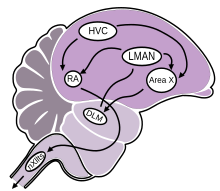Wikipedia:WikiProject Open/Open access task force/Open Access File of the Day/2012/February/16
Here comes another example of a figure that has been recreated in SVG format to make it editable. It schematically depicts the anterior and posterior song-learning pathways in birds, as explained in [[Bird vocalization]]

Source: Nottebohm, F. (2005). "The Neural Basis of Birdsong". PLOS Biology. 3 (5): e164. doi:10.1371/journal.pbio.0030164. PMC 1110917. PMID 15884976.
- Anterior forebrain pathway (vocal learning): composed of Area X, which is a homologue to mammalian basal ganglia; the lateral part of the magnocellular nucleus of anterior neostriatum (LMAN), also considered a part of the avian basal ganglia; and the dorso-lateral division of the medial thalamus (DLM).
- Posterior descending pathway (vocal production): composed of HVC (proper name, although sometimes referred to as the high vocal center); the robust nucleus of the arcopallium (RA); and the tracheosyringeal part of the hypoglossal nucleus (nXIIts).[1][2]
References edit
- ^ Brainard, M. S. & Doupe, A. J. (2000). "Auditory feedback in learning and maintenance of vocal behavior". Nature Rev. Neurosci. 1 (1): 31–40. doi:10.1038/35036205. PMID 11252766. S2CID 5133196.
- ^ Carew, Thomas J. (2000). Behavioral Neurobiology: The Cellular Organization of Natural Behavior. Sinauer Associates, Inc. ISBN 978-0878930920.